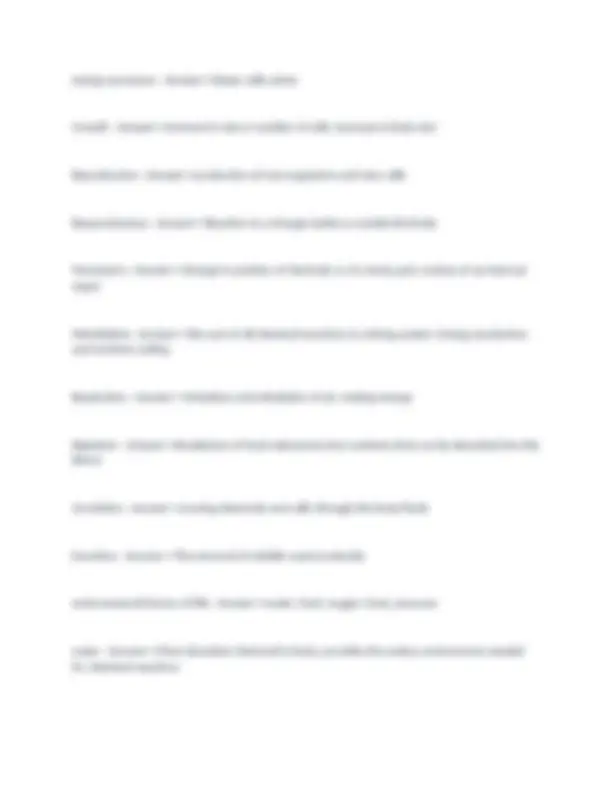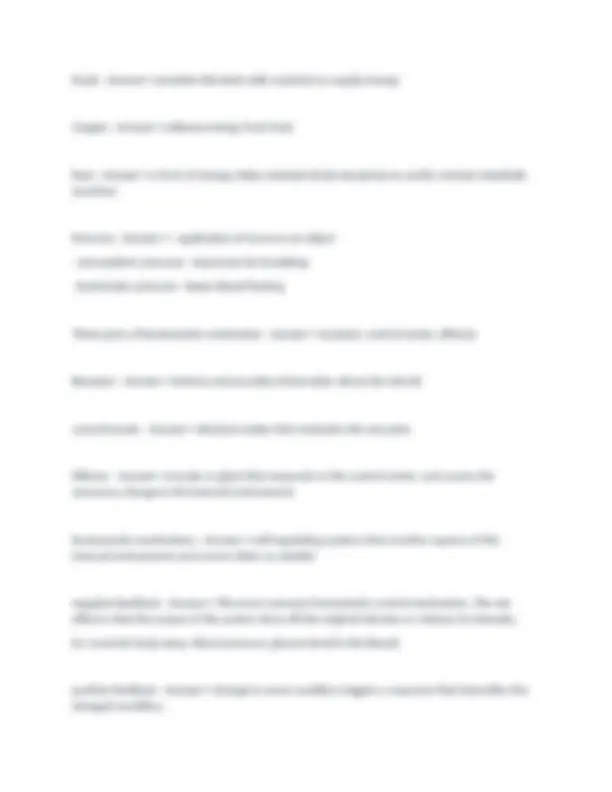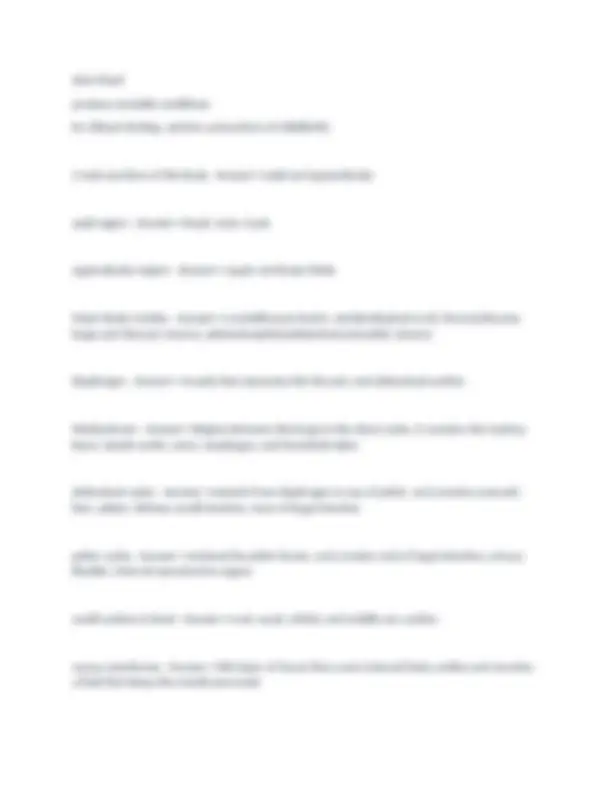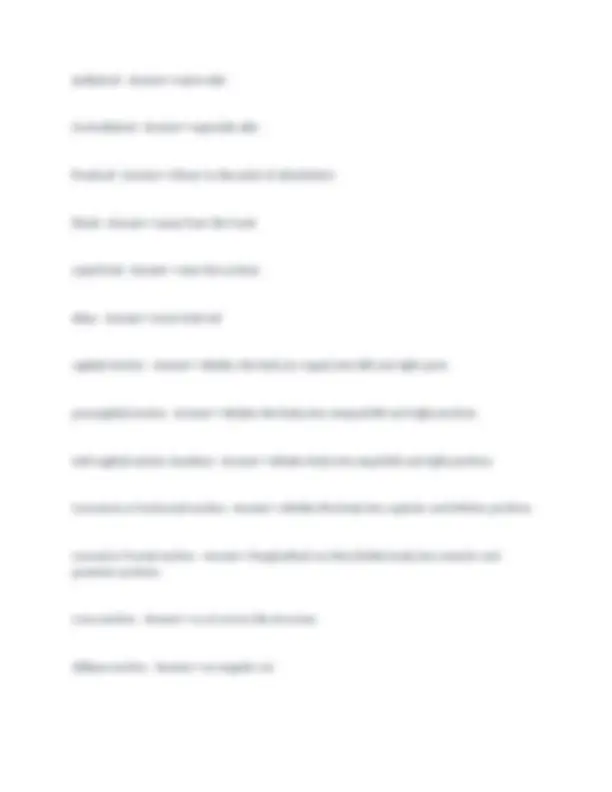







Study with the several resources on Docsity

Earn points by helping other students or get them with a premium plan


Prepare for your exams
Study with the several resources on Docsity

Earn points to download
Earn points by helping other students or get them with a premium plan
Community
Ask the community for help and clear up your study doubts
Discover the best universities in your country according to Docsity users
Free resources
Download our free guides on studying techniques, anxiety management strategies, and thesis advice from Docsity tutors
A comprehensive test bank for the introductory chapter of anatomy and physiology. It includes definitions and answers for various concepts such as atoms, molecules, organelles, cells, tissues, organs, organ systems, homeostasis, and environmental factors. It also covers topics related to body cavities, the integumentary, skeletal, muscular, nervous, endocrine, cardiovascular, lymphatic, digestive, respiratory, urinary, and reproductive systems.
Typology: Exams
1 / 9

This page cannot be seen from the preview
Don't miss anything!






Anatomy - Answer>>The study of body structure Physiology - Answer>>The study of body function subatomic particles - Answer>>protons, neutrons, electrons Atom - Answer>>tiny particles that make up chemicals (hydrogen, carbon) Molecule - Answer>>A group of atoms bonded together Macromolecules - Answer>>A very large organic molecule composed of many smaller molecules Organelle - Answer>>A tiny cell structure that carries out a specific function within the cell Cell - Answer>>The basic unit of structure and function in living things Tissues - Answer>>layers or mass of cells with specific function Organ - Answer>>A group of tissues working together to perform a specific function organ system - Answer>>group of organs that work together to perform a common function Organism - Answer>>A living thing
Ultrasound - Answer>>high-frequency sound waves used to create an image of a developing fetus magnetic resonance imaging (MRI) - Answer>>Magnetic field changes alignment and spin of certain types of atoms; provides high-resolution images of internal structures, such as the brain internal environment - Answer>>environment within the body Homeostasis - Answer>>The maintenance of a constant internal environment structure and function - Answer>>interrelated interdependency of cells - Answer>>cells depend on each other Gradients and Permeability - Answer>>Cells move from high to low, down pressure and concentration gradients, across permeable membranes cellular differentiation - Answer>>specialization of cells due to gene expression cell membrane mechanisms - Answer>>Determine entry of substances, responds to signals cell to cell communication - Answer>>via membrane receptors feedback loop - Answer>>homeostatic mechanisms for stability Balance - Answer>>replacement of lost substances, elimination of excesses
foods - Answer>>provides the body with nutrients to supply energy Oxygen - Answer>>releases energy from food heat - Answer>>a form of energy, helps maintain body temperature, partly controls metabolic reactions Pressure - Answer>>- application of force on an object
short lived produce unstable conditions Ex: (blood clotting, uterine contractions of childbirth) 2 main portions of the body - Answer>>axial and appendicular axial region - Answer>>head, neck, trunk appendicular region - Answer>>upper and lower limbs Major Body Cavities - Answer>>cranial(houses brain), vertebral(spinal cord), thoracic(houses lungs and thoracic viscera), abdominopelvic(abdominal and pelvic viscera) Diaphragm - Answer>>muscle that separates the thoracic and abdominal cavities Mediastinum - Answer>>Region between the lungs in the chest cavity. It contains the trachea, heart, lymph nodes, aorta, esophagus, and bronchial tubes. abdominal cavity - Answer>>extends from diaphragm to top of pelvis, and contains stomach, liver, spleen, kidneys small intestine, most of large intestine pelvic cavity - Answer>>enclosed by pelvic bones, and contains end of large intestine, urinary bladder, internal reproductive organs small cavities in head - Answer>>oral, nasal, orbital, and middle ear cavities serous membrane - Answer>>thin layer of tissue that covers internal body cavities and secretes a fluid that keeps the membrane moist
digestive system - Answer>>Receives food, breaks down food, excretes waste respiratory system - Answer>>moves air in and out of the body, exchanges gases between blood and air; absorbs oxygen urinary system - Answer>>removes waste products from blood and maintains water balance within body reproductive system - Answer>>produces offspring anatomical position - Answer>>To stand erect with arms at the sides and palms of the hands turned forward Superior - Answer>>above Inferior - Answer>>below Anterior (ventral) - Answer>>toward the front Posterior (dorsal) - Answer>>toward the back Medial - Answer>>toward the midline Lateral - Answer>>away from the midline bilateral - Answer>>paired structures; on both sides
Ipsilateral - Answer>>same side Contralateral - Answer>>opposite side Proximal - Answer>>Closer to the point of attachment Distal - Answer>>away from the trunk superficial - Answer>>near the surface deep - Answer>>more internal sagittal section - Answer>>divides the body (or organ) into left and right parts parasagittal section - Answer>>divides the body into unequal left and right portions mid-sagittal section (median) - Answer>>divides body into equal left and right portions transverse or horizontal section - Answer>>divides the body into superior and inferior portions coronal or frontal section - Answer>>longitudinal cut that divides body into anterior and posterior portions cross-section - Answer>>a cut across the structure oblique section - Answer>>an angular cut